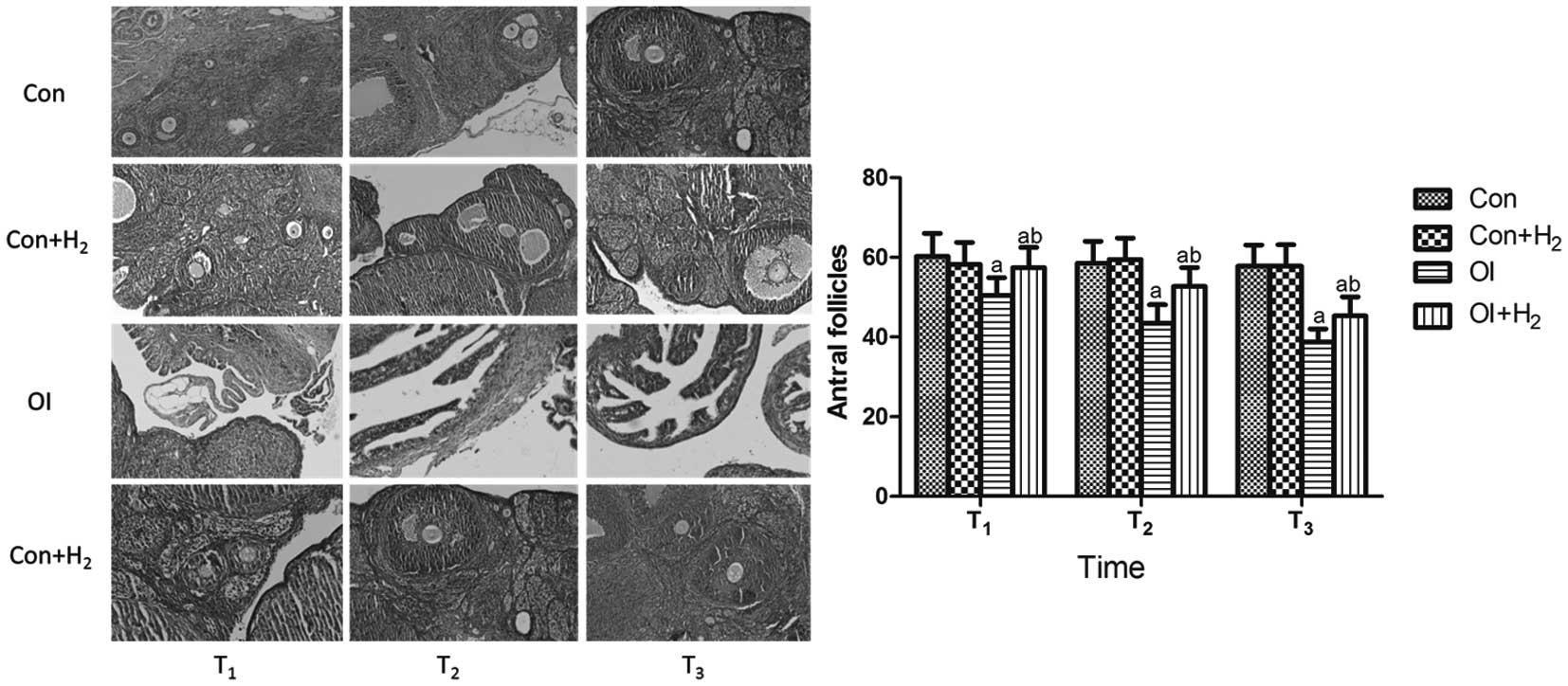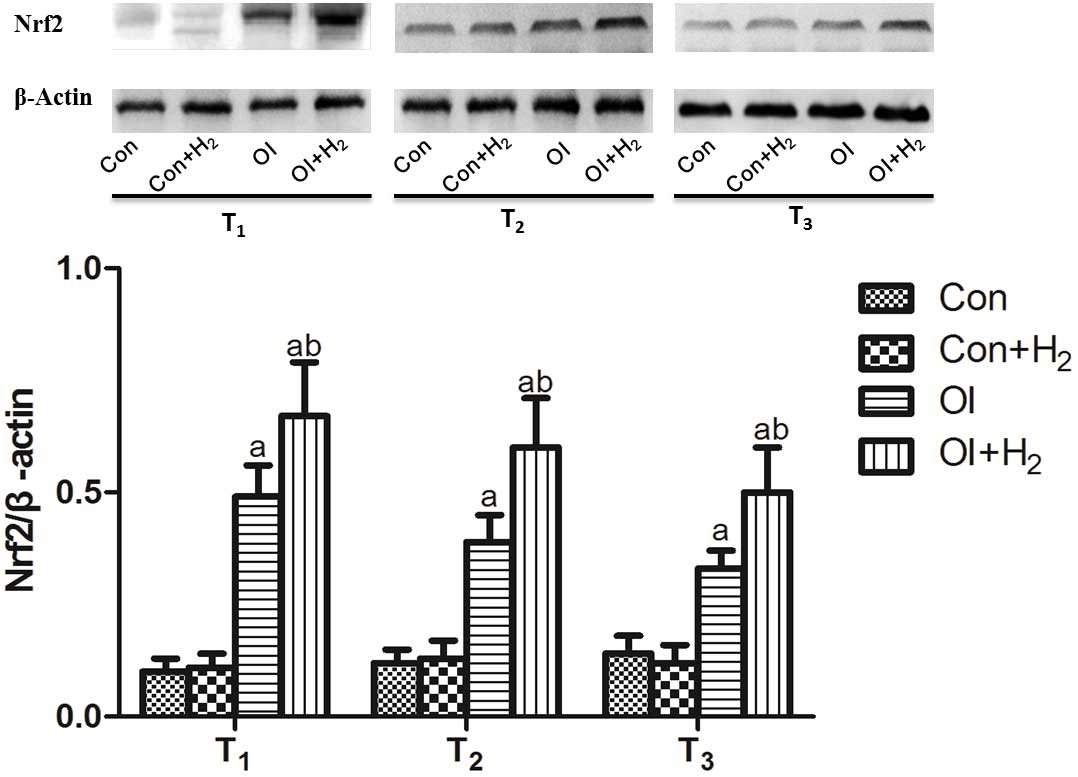|
1
|
Jemal A, Siegel R, Ward E, Murray T, Xu J
and Thun MJ: Cancer statistics, 2007. CA Cancer J Clin. 57:43–66.
2007. View Article : Google Scholar : PubMed/NCBI
|
|
2
|
Lee HJ, Selesniemi K, Niikura Y, Niikura
T, Klein R, Dombkowski DM and Tilly JL: Bone marrow transplantation
generates immature oocytes and rescues long-term fertility in a
preclinical mouse model of chemotherapy-induced premature ovarian
failure. J Clin Oncol. 25:3198–3204. 2007. View Article : Google Scholar : PubMed/NCBI
|
|
3
|
Zhang Y, Cheng Y, Ren X, Zhang L, Yap KL,
Wu H, Patel R, Liu D, Qin ZH, Shih IM and Yang JM: NAC1 modulates
sensitivity of ovarian cancer cells to cisplatin by altering the
HMGB1-mediated autophagic response. Oncogene. 31:1055–1064. 2012.
View Article : Google Scholar : PubMed/NCBI
|
|
4
|
Silver DP, Richardson AL, Eklund AC, Wang
ZC, Szallasi Z, Li Q, Juul N, Leong CO, Calogrias D, Buraimoh A, et
al: Efficacy of neoadjuvant Cisplatin in triple-negative breast
cancer. J Clin Oncol. 28:1145–1153. 2010. View Article : Google Scholar : PubMed/NCBI
|
|
5
|
Bae-Jump VL, Zhou C, Boggess JF and Gehrig
PA: Synergistic effect of rapamycin and cisplatin in endometrial
cancer cells. Cancer. 115:3887–3896. 2009. View Article : Google Scholar : PubMed/NCBI
|
|
6
|
Hu J and Friedman E: Depleting Mirk kinase
increases cisplatin toxicity in ovarian cancer cells. Genes Cancer.
1:803–811. 2010. View Article : Google Scholar : PubMed/NCBI
|
|
7
|
Morgan S, Lopes F, Gourley C, Anderson RA
and Spears N: Cisplatin and doxorubicin induce distinct mechanisms
of ovarian follicle loss; imatinib provides selective protection
only against cisplatin. PLoS One. 8:e701172013. View Article : Google Scholar : PubMed/NCBI
|
|
8
|
Xie K, Yu Y, Pei Y, Hou L, Chen S, Xiong L
and Wang G: Protective effects of hydrogen gas on murine
polymicrobial sepsis via reducing oxidative stress and HMGB1
release. Shock. 34:90–97. 2010. View Article : Google Scholar : PubMed/NCBI
|
|
9
|
Xie K, Yu Y, Zhang Z, Liu W, Pei Y, Xiong
L, Hou L and Wang G: Hydrogen gas improves survival rate and organ
damage in zymosan-induced generalized inflammation model. Shock.
34:495–501. 2010. View Article : Google Scholar : PubMed/NCBI
|
|
10
|
Qu J, Li X, Wang J, Mi W, Xie K and Qiu J:
Inhalation of hydrogen gas attenuates cisplatin-induced ototoxicity
via reducing oxidative stress. Int J Pediatr Otorhinolaryngol.
76:111–115. 2012. View Article : Google Scholar : PubMed/NCBI
|
|
11
|
Matsushita T, Kusakabe Y, Kitamura A,
Okada S and Murase K: Investigation of protective effect of
hydrogen-rich water against cisplatin-induced nephrotoxicity in
rats using blood oxygenation level-dependent magnetic resonance
imaging. Jpn J Radiol. 29:503–512. 2011. View Article : Google Scholar : PubMed/NCBI
|
|
12
|
Nakashima-Kamimura N, Mori T, Ohsawa I,
Asoh S and Ohta S: Molecular hydrogen alleviates nephrotoxicity
induced by an anti-cancer drug cisplatin without compromising
anti-tumor activity in mice. Cancer Chemother Pharmacol.
64:753–761. 2009. View Article : Google Scholar : PubMed/NCBI
|
|
13
|
Zheng X, Mao Y, Cai J, Li Y, Liu W, Sun P,
Zhang JH, Sun X and Yuan H: Hydrogen-rich saline protects against
intestinal ischemia/reperfusion injury in rats. Free Radic Res.
43:478–484. 2009. View Article : Google Scholar : PubMed/NCBI
|
|
14
|
Hayashida K, Sano M, Ohsawa I, Shinmura K,
Tamaki K, Kimura K, Endo J, Katayama T, Kawamura A, Kohsaka S, et
al: Inhalation of hydrogen gas reduces infarct size in the rat
model of myocardial ischemia-reperfusion injury. Biochem Biophys
Res Commun. 373:30–35. 2008. View Article : Google Scholar : PubMed/NCBI
|
|
15
|
Li X, Yang S, Lv X, Sun H, Weng J, Liang Y
and Zhou D: The mechanism of mesna in protection from
cisplatin-induced ovarian damage in female rats. J Gynecol Oncol.
24:177–185. 2013. View Article : Google Scholar : PubMed/NCBI
|
|
16
|
Dale O, Mortensen B, Thommesen L and Hagen
B: Cisplatin toxicity in the rat may be influenced by anaesthetic
agents. Acta Anaesthesiol Scand. 44:7702000. View Article : Google Scholar : PubMed/NCBI
|
|
17
|
Oktay K, Schenken RS and Nelson JF:
Proliferating cell nuclear antigen marks the initiation of
follicular growth in the rat. Biol Reprod. 53:295–301. 1995.
View Article : Google Scholar : PubMed/NCBI
|
|
18
|
Cheng X, Ku CH and Siow RC: Regulation of
the Nrf2 antioxidant pathway by microRNAs: New players in
micromanaging redox homeostasis. Free Radic Biol Med. 64:4–11.
2013. View Article : Google Scholar : PubMed/NCBI
|
|
19
|
Li Y, Li X, Wong YS, Chen T, Zhang H, Liu
C and Zheng W: The reversal of cisplatin-induced nephrotoxicity by
selenium nanoparticles functionalized with 11-mercapto-1-undecanol
by inhibition of ROS-mediated apoptosis. Biomaterials.
32:9068–9076. 2011. View Article : Google Scholar : PubMed/NCBI
|
|
20
|
Belotte J, Fletcher NM, Awonuga AO, Alexis
M, Abu-Soud HM, Saed MG, Diamond MP and Saed GM: The role of
oxidative stress in the development of cisplatin resistance in
epithelial ovarian cancer. Reprod Sci. 21:503–508. 2014. View Article : Google Scholar : PubMed/NCBI
|
|
21
|
Dole M, Wilson FR and Fife WP: Hyperbaric
hydrogen therapy: A possible treatment for cancer. Science.
190:152–154. 1975. View Article : Google Scholar : PubMed/NCBI
|
|
22
|
Saitoh Y, Yoshimura Y, Nakano K and Miwa
N: Platinum nanocolloid-supplemented hydrogen-dissolved water
inhibits growth of human tongue carcinoma cells preferentially over
normal cells. Exp Oncol. 31:156–162. 2009.PubMed/NCBI
|
|
23
|
Oyawoye O, Gadir Abdel A, Garner A,
Constantinovici N, Perrett C and Hardiman P: Antioxidants and
reactive oxygen species in follicular fluid of women undergoing
IVF: Relationship to outcome. Hum Reprod. 18:2270–2274. 2003.
View Article : Google Scholar : PubMed/NCBI
|
|
24
|
Crha I, Hrubá D, Ventruba P, Fiala J,
Totusek J and Visnová H: Ascorbic acid and infertility treatment.
Cent Eur J Public Health. 11:63–67. 2003.PubMed/NCBI
|
|
25
|
Carbone MC, Tatone C, Delle Monache S,
Marci R, Caserta D, Colonna R and Amicarelli F: Antioxidant
enzymatic defences in human follicular fluid: Characterization and
age-dependent changes. Mol Hum Reprod. 9:639–643. 2003. View Article : Google Scholar : PubMed/NCBI
|
|
26
|
Török A, Belágyi J, Török B, Tinneberg HR
and Bódis J: Scavenger capacity of follicular fluid, decidua and
culture medium with regard to assisted reproduction: An in vitro
study using electron paramagnetic resonance spectroscopy. Gynecol
Obstet Invest. 55:178–182. 2003. View Article : Google Scholar : PubMed/NCBI
|
|
27
|
Cohen M, Lippman M and Chabner B: Role of
pineal gland in aetiology and treatment of breast cancer. Lancet.
2:814–816. 1978. View Article : Google Scholar : PubMed/NCBI
|
|
28
|
Matzuk MM, Dionne L, Guo Q, Kumar TR and
Lebovitz RM: Ovarian function in superoxide dismutase 1 and 2
knockout mice. Endocrinology. 139:4008–4011. 1998. View Article : Google Scholar : PubMed/NCBI
|
|
29
|
Nguyen T, Yang CS and Pickett CB: The
pathways and molecular mechanisms regulating Nrf2 activation in
response to chemical stress. Free Radic Biol Med. 37:433–441. 2004.
View Article : Google Scholar : PubMed/NCBI
|
|
30
|
Dinkova-Kostova AT, Holtzclaw WD, Cole RN,
Itoh K, Wakabayashi N, Katoh Y, Yamamoto M and Talalay P: Direct
evidence that sulfhydryl groups of Keap1 are the sensors regulating
induction of phase 2 enzymes that protect against carcinogens and
oxidants. Proc Natl Acad Sci USA. 99:11908–11913. 2002. View Article : Google Scholar : PubMed/NCBI
|
|
31
|
Hu X, Roberts JR, Apopa PL, Kan YW and Ma
Q: Accelerated ovarian failure induced by 4-vinyl cyclohexene
diepoxide in Nrf2 null mice. Mol Cell Biol. 26:940–954. 2006.
View Article : Google Scholar : PubMed/NCBI
|


















